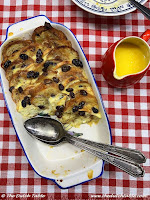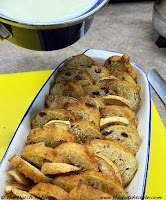"Wie wat bewaard, die heeft wat" said my oma Pauline triumphantly many times, "he who saves something, has something". She lived through the two wars and was resourceful and frugal, a quality that many of us will recognize in our parents and grandparents who lived through those times. Saving is one type of skill, and so is making leftovers into another tasty dish, so that food does not go to waste. And that is so true for today's leftovers, oliebollen from New Year's Eve. Oliebollen are best freshly fried, but make for a wonderful bread pudding. So, IF there are any left or if you have a chance to bake some extra and set them aside, this may be a great way to welcome the new year: bread puddings are a lovely treat for breakfast!
And as with so many of our recipes, make this your own. If you like raisins, you can always sprinkle them in with the sliced oliebollen, or add a chopped apple, dried apricots, or leftover cranberry sauce from your Christmas dinner, a handful of walnuts......as you can see there are plenty of opportunities to come up with a new family favorite!
Oliebollenbroodschotel
8 oliebollen1 tablespoon butter (15 grams)
1 cup (250 ml) milk
1/2 cup (125 ml cream)
2 tablespoons sugar
2 eggs
1 teaspoon vanilla essence
Optional: dried fruits, apple slices, vanilla pudding, cinnamon, powdered sugar
Heat the oven to 375F. Butter a casserole or baking dish. Slice the oliebollen and place them upright, alternating, in the casserole, so that they're nice and snug. Mix the milk with the cream and the sugar, and warm slightly on the stove, stirring until the sugar is dissolved. Remove from the stove, let it cool down to lukewarm, beat the eggs and stir into the milk, together with the vanilla. Pour over the oliebollen in the dish, but make sure that the liquid stays beneath the casserole line.
Bake on a baking tray for 25 - 30 minutes. As the top oliebollen stay exposed (and crisp up) you may want to check after 15 minutes to make sure they're not burning. If they are getting too dark, cover the dish with aluminum foil.
Sprinkle with cinnamon, and/or powdered sugar, or serve with warm vanilla pudding or custard.












